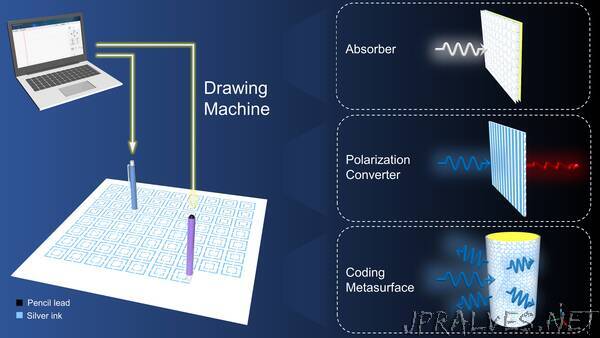
“New approach creates metamaterials that are light, thin and flexible
Researchers have developed an automatic drawing machine that uses pens and pencils to draw metamaterials onto paper. They demonstrated the new approach by using it to make three metamaterials that can be used to manipulate the microwave region of the electromagnetic spectrum.
Metamaterials are artificially engineered composite materials that derive their properties from patterned microstructures, rather than the chemical composition of the materials themselves. The exact shape, geometry, size, orientation and arrangement of the structures can be used to manipulate electromagnetic waves in ways that aren’t possible with conventional materials.
“Metamaterials, especially those used as absorbers, generally need to be thin, lightweight, wide and strong, but it isn’t easy to create thin and lightweight devices using traditional substrates,” said research team leader Junming Zhao from Nanjing University in China. “Using paper as the substrate can help meet these requirements while also lending itself to metasurfaces that conform to a surface or that are mechanically reconfigurable.”
In the journal Optical Materials Express, the researchers describe their new technique, which uses a ballpoint pen with conductive ink to draw conductors and mechanical pencils to draw resistors and resistive films. They incorporated this process into a computer-controlled drawing machine to make it more automatic and accurate.
“Although paper-based metamaterials have been made previously using inkjet printing technology, our drawing technique is lower cost, simpler and more flexible,” said Zhao. “Our method could be useful for making reconfigurable antennas and metalenses as well as metamaterial devices that absorb incident electromagnetic energy from cell phones or other sources.”
Automated drawing
The new drawing machine uses pens with ink containing conductive material or normal mechanical pencils with varying graphite content. It has three stepper motors, two of which control the movement of the pen or pencil in the horizontal plane, while the other lifts or drops the writing instrument in the vertical plane. The parameters of the drawing machine, such as the movement speed, are controlled by a computer.
“Some of the paper we tried was not very compatible with the pencils or conductive ink pens, resulting in poor conductivity of the drawn patterns,” said Zhao. “After some testing, we found the best performance came from using paper that is .22 mm thick, which is easy to obtain and very compatible with the pencils and conductive ink.”
The researchers used the conductive ink pen to draw patterns on paper and found the patterns to have a good conductivity of 3×106 Siemens per meter. They also tested pencils with various amounts of graphite, drawing times and drawing pressures to characterize how these factors affected electrical resistance. This allowed them to calculate the conditions needed for drawing patterns with a specific resistance.
Creating paper metamaterials
Using their new drawing technique, the researchers designed and fabricated three different paper-based metamaterials: a polarization converter, an absorber and a conformal coding metasurface. They showed that the polarization converter could rotate linear polarization by 90° with a conversion efficiency of over 90% from 3.1 to 6.6 GHz. The absorber they fabricated had a mass of just 58.3 grams and achieved 90% absorptivity between 2.1 GHz to 10.5 GHz.
The researchers also created a conformal coding metasurface that could be used for radar cross-section reduction, which is used to hide the radar signal in military aircraft and ships. This metasurface had two structural units with a 180° reflection phase difference to each other, which allowed them to act as ‘0’ and ‘1’ elements for 1-bit coding. When bent around a curved surface, this metasurface achieved a 10 dB radar cross-section reduction over a frequency band from 8.94 to 11.59 GHz.
“We hope that in the future, we can use the drawing technology to design and fabricate meta-devices that could be carried or applied to the skin to achieve electromagnetic shielding and other functions,” said Zhao. “We also plan to design mechanically reconfigurable metamaterials that take advantage of the fact that paper can be bent and folded.”
Paper: K. Zhu, S. Hao, K. Chen, T. Jiang, J. Zhao, Y. Feng, “Directly drawing metamaterials on paper based on an automatic drawing machine,” Opt. Mater. Express 12, 11, pp. 4299-4309 (2022).
DOI: https://doi.org/10.1364/OME.472866”
